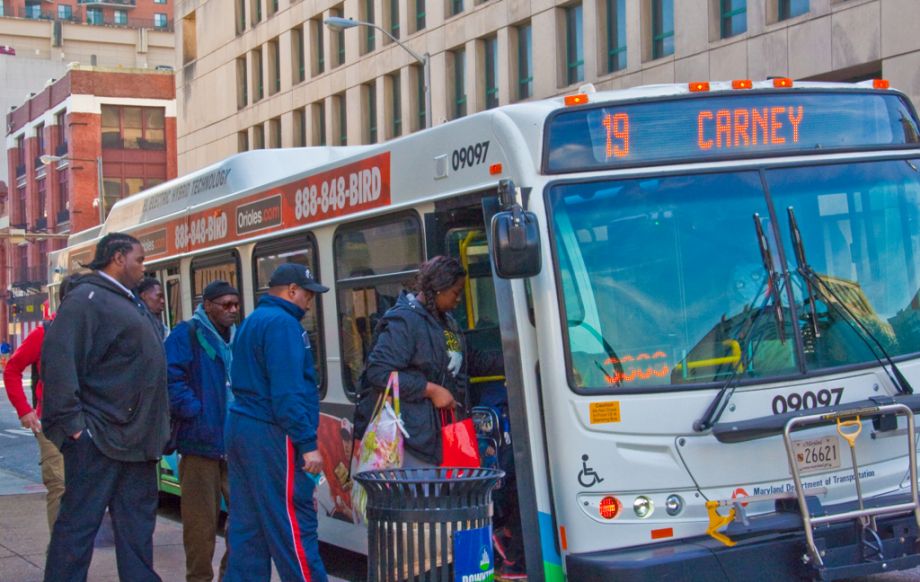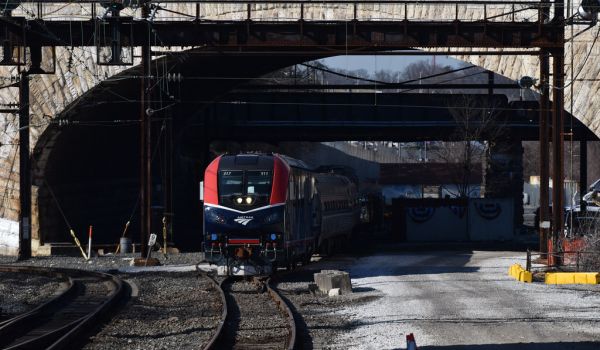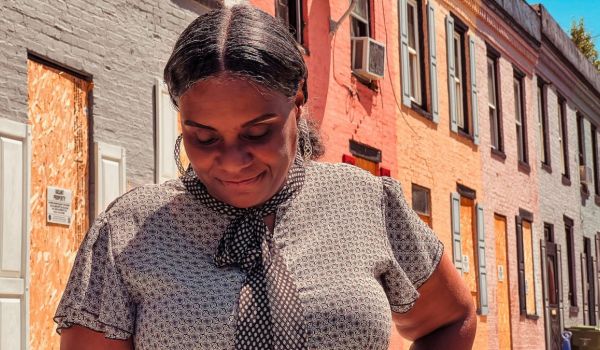Welcome to “The Mobile City,” our weekly roundup of noteworthy transportation developments.
Baltimore Rolls Out a Flexible Transit Pass
Even as knowledge workers gradually and haltingly return to their offices as vaccination rates rise, it’s quite likely that five-day office workweeks will become a thing of the past. Now Mass Transit reports that one transit agency is reshaping its discount transit passes to reflect this new reality.
An Aug. 27 news release in the publication announced that the Maryland Department of Transportation Maryland Transit Administration (MDOT MTA) has rolled out new three- and 10-day transit passes called CharmFlex, available to users of the agency’s CharmPass mobile fare payment app.
CharmFlex passes differ from regular passes in that they can be used on either consecutive or non-consecutive days. They are also good for 12 months from the date of purchase. The passes are good on all MDOT MTA services and l offer a 15 percent discount from the price of a day pass or single-trip fare.
“As Maryland’s economy continues to recover and riders return to transit, we’re excited to offer new fare options that address the needs of our riders,” MDOT MTA Acting Administrator Holly Arnold said in the release. “CharmFlex provides the best value for riders traveling only a few times a week or on non-consecutive days.”
The launch of the CharmFlex pass coincided with the restoration of full service on the MTA and MARC systems on Aug. 30. Even though ridership remains well below pre-pandemic levels, it has risen since the spring of this year: ridership in the spring quarter of 2021 on all MDOT MTA services was up 20 percent from its pandemic-induced 2020 level.
Advocates Push House to Add Back Transit Funding Removed from Infrastructure Bill
The $39 billion allocated to mass transit in the bipartisan infrastructure bill now before the House is more than the federal government has ever committed to transit. But according to a report in The Hill, the original bipartisan agreement involving the Senate and the Biden administration had an additional $10 billion for transit in it.
“The bipartisan group of senators and the White House agreed to boost transit funding by $49 billion in the deal they proudly touted,” Beth Osborne, director of Transportation for America, said in a statement Monday. “But they dropped $10 billion, abandoning their own deal for no reason.”
Her group is part of a coalition of 45 trade associations, labor unions and environmental groups that is now urging the House to put the missing $10 billion back in. The coalition bases its advocacy on environmental and equity grounds. As Sierra Club President Ramon Cruz put it in a statement, “Transportation is the largest source of climate-disrupting emissions in the U.S., and a major source of air pollution, especially in low-income communities and communities of color. But Congress has the power to change that. All communities deserve access to clean and reliable mobility options.”
If the group achieves its goal, the missing money will most likely be included in the budget reconciliation bill that will need only Democratic votes to pass.
Something similar happened in Wisconsin, whose Republican-controlled legislature cut $40 million in state funding for transit systems in the state’s two biggest cities this summer, citing cost savings. The Milwaukee Journal Sentinel reports that Democratic Gov. Tony Evers has cushioned the blow by sending an additional $25 million in federal funding the two cities’ way: $19.7 million for the Milwaukee County transit system and $5.2 million for Madison Metro Transit. The legislature did not cut state funding for any other transit systems in the state.
“For our most urban centers to be targeted by Republican cuts during the last budget was a slap in the face to the disproportionate number of Wisconsinites in those communities who depend on public transit to get to school, work, doctor’s appointments— you name it,” Evers said in a statement.
Charlotte Plays Catch-Up on Sidewalk Repairs
WBTV in Charlotte reports that, after an investigation it conducted in February found that the city had 242 unfunded sidewalk repair projects that had been on the waiting list for 15 years or more, the city council has voted to borrow more than three times what the city had been spending on sidewalk repairs in the coming fiscal year.
The bond issue authorized by the council will raise the funding for sidewalk repairs from $15 million to $50 million in fiscal 2022. Voters must approve the bonds at an election next year before they can be issued.
The station’s investigation found flaws in the system the city used to rate sidewalk quality and prioritize projects. It also found that the city was not regularly re-evaluating sidewalk projects to see whether some repairs should move up the list.
Ashley Landis, deputy manager of the Charlotte Department of Transportation’s planning and design division, was ecstatic over the huge rise in funding: “We’re going to be able to accelerate our projects, deliver more projects, and really spread out the projects across the city,” she told the station.
In the city’s fiscal 2022 budget, 20 percent of the money will be reserved for sidewalk construction in suburban areas.
New Jersey Banks on Buses (or Some Other Transit) to Shore Up Struggling Shopping Mall
Many urbanists back mass transit because, they argue, it can serve as a tool for reshaping neighborhoods and communities to promote walkability and better urban form. According to a story in the commercial real estate industry publication The Real Deal, however, New Jersey Transit Corporation plans on sending transit to the rescue of a troubled shopping mall.
The mall in question is the American Dream Mall, the huge retail/recreational complex in the Meadowlands near MetLife Stadium. According to the article, the mall, which has been opening in phases starting in October 2019 but shut down completely for six months in 2020 due to the pandemic, has a huge debt burden that its owner is tapping cash reserves to pay off.
But according to NJ.com’s story on NJT’s proposal to build a new “Transitway” connecting both the mall and the adjacent MetLife Stadium with the bus terminal at Secaucus Junction train station, the crisis NJT hopes to stave off is one of traffic: NJT has visions of nightmare traffic on days when the Giants or Jets are playing at MetLife Stadium and the mall is fully open and operational.
A traffic study undertaken in 2012, while construction on the mall was suspended due to a dispute between its owner and the football teams, predicted that 151,000 weekday visitors would come to the mall once it is completed. While Bergen County prohibits retail sales on Sundays, the ban does not extend to amusement parks, which means the American Dream Mall’s amusement park would be open during games.
The agency has just begun to study the idea and has yet to settle on a mode of choice, but the chosen alignment strongly favors bus service. The proposed 7.2-mile route would use government-owned property exclusively to connect the destinations: an existing busway at Secaucus Junction, an abandoned NJT rail line, bus lanes on the New Jersey Turnpike and a dedicated right-of-way at the Meadowlands Sports Complex.
The route would need to carry more than the 10,000 passengers per hour an existing rail line serving the stadium can carry, according to the report.
The proposal has already drawn criticism for both its planned route and its possible cost. A former Long Island Rail Road planning director quoted in the story pointed out that the route requires the rebuilding of a 123-year-old railroad bridge and could take longer than simply riding an express bus from the Port Authority Bus Terminal to the Meadowlands.
Other critics raised questions about paying for the project. “Our capital plan isn’t fully funded. Why wouldn’t other entities be participating in funding this project, especially American Dream and the Meadowlands,” asked NJT board member James D. Adams. “Why does it appear NJ Transit is fully funding this?” Both he and fellow board member Robert Gordon argued that both the mall and the teams should pick up some of the tab and that public-private partnerships be explored for building the line.
Know of a development that should be featured in this column? Send a Tweet with links to @MarketStEl using the hashtag #mobilecity.

Next City contributor Sandy Smith is the home and real estate editor at Philadelphia magazine. Over the years, his work has appeared in Hidden City Philadelphia, the Philadelphia Inquirer and other local and regional publications. His interest in cities stretches back to his youth in Kansas City, and his career in journalism and media relations extends back that far as well.
Follow Sandy .(JavaScript must be enabled to view this email address)
















